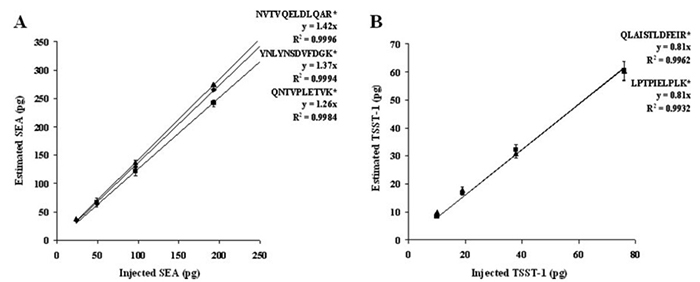Mass Standard Protein Production
Mass spectrometry (MS) has revolutionized protein detection, identification , and quantitation in modern biology and biopharma. To support the growing demand for accurate and reproducible MS-based workflows, Creative BioMart now offers Mass Standard Protein Production for over 10,000 human proteins. These full-length proteins , expressed in HEK293T cells and metabolically labeled with heavy isotopes, serve as highly reliable internal standards for a wide range of proteomic applications. Achieve superior data consistency, authentic post-translational modifications (PTMs), and accurate quantification in every experiment.

Background: What Is a Mass Standard Protein and Why It Matters
Mass standard proteins are isotopically labeled proteins designed to act as internal standards in MS workflows. Unlike synthetic peptides , which often lack native folding or post-translational modifications, full-length proteins expressed in human cells provide a biologically relevant and accurate standard.
Key Uses and Applications
- Quantitative proteomics using SRM/MRM or label-based approaches
- Biopharmaceutical characterization, including biomarker validation
- Diagnostic assay development for clinical applications
- Quality control for reproducible sample preparation and analysis
Advantages Over Peptide Standards
- Retain authentic PTMs for better mimicry of native proteins
- Support accurate quantification by spiking into complex biological samples
- Enable higher consistency across experiments and laboratories
- Versatile—compatible with all major MS platforms and workflows
How Are Mass Standard Proteins Produced
At Creative BioMart, we express full-length human proteins in HEK293T cells, a mammalian system known for optimal post-translational processing. The proteins are metabolically labeled with [U-¹³C₆, ¹⁵N₄]-L-Arginine and [U-¹³C₆, ¹⁵N₂]-L-Lysine , achieving over 90% incorporation efficiency. This allows seamless quantification against endogenous proteins during MS analysis.
Overview of Our Mass Standard Protein Production Service
Service Procedure

Sample Preparation and Workflow Integration
Proper sample preparation is essential in MS-based proteomics, as it greatly affects data quality and reproducibility. Leading labs understand that preparation, instrumentation, and software must work together in an integrated workflow to ensure consistent, high-quality results.
At Creative BioMart, we provide comprehensive support for every step of your proteomics workflow:
- Sample Preparation : We offer detailed protocols and optimized kits to ensure high-quality sample preparation.
- Instrumentation Compatibility : Our standards are designed to work seamlessly with all major MS platforms.
- Data Analysis : We provide guidance on data analysis and interpretation to help you get the most out of your MS experiments.
Service Details
-

Expression Host
HEK293T human cells
-

Labeling Method
SILAC-based metabolic labeling
-
![Isotopic labels used: [U-13C6, 15N4]-L-Arginine and [U-13C6, 15N2]-L-Arginine](/images/mass-standard-protein-production-section-3-4.jpg)
Isotopes Used
U-13C6, 15N4]-L-Arginine [U-13C6, 15N2]-L-Arginine
-

Purity
≥90% by SDS-PAGE and LC-MS/MS
-

Label Incorporation
>90% efficiency
-

Custom Options
Protein concentration, buffer conditions, expression scale, etc.
Why Choose Us–Mass Standard Protein Production Advantages
- Authentic PTMs : Full-length proteins mirror native biological forms.
- Superior Quantification : Ideal for spiking in SRM, MRM, or DIA workflows.
- Consistency Across Experiments : Better reproducibility than synthetic peptides.
- Broad Compatibility : Suitable for all types of MS equipment and platforms.
- High Efficiency Labeling : >90% incorporation of heavy isotopes ensures accuracy.
- End-to-End Expertise : From gene to mass-spec-ready protein, we've got you covered.
Case Studies of Mass Standard Protein Production for Quantitative Proteomics
* NOTE: We prioritize confidentiality to safeguard our clients’ technology and intellectual property. As an alternative, we present selected published research articles as representative case studies. For details on the assay services and products used in these studies, please refer to the relevant sections of the cited literature.
Case 1: Isotope-labeled protein standards
Brun et al. , 2007. doi:10.1074/mcp.M700163-MCP200
Diagnostic development and public health surveillance increasingly rely on technologies capable of precise protein biomarker identification and quantification. While traditional immunoassays remain common, mass spectrometry (MS) offers superior sensitivity and specificity. However, chemically synthesized isotope-labeled peptides—commonly used as MS standards—can introduce significant biases. This study presents an improved approach: Protein Standard Absolute Quantification (PSAQ), which uses isotope-labeled full-length proteins as internal standards. These standards closely mimic the target proteins’ properties, enabling accurate quantification even in complex or fractionated samples. PSAQ was successfully validated using water and urine samples containing Staphylococcus aureus toxins—biomarkers relevant to public health.

Figure 1. Quantification of SEA and TSST-1 in drinking water using PSAQ standards. SEA (A) and TSST-1 (B) were spiked into water samples with PSAQ standards, digested with trypsin, and quantified by nano-LC-MS using specific marker peptides. (Brun et al ., 2007)
Case 2: HEK293T-expressed SILAC proteins for MS quantification
Sampedro-Castañeda et al ., 2023. doi:10.1038/s41467-023-43475-w
A SILAC-based phosphoproteomics study in mouse cortical neurons demonstrated the high efficiency and accuracy of metabolic labeling using [U-13C6, 15N4]-L-Arginine and [U-13C6, 15N2]-L-Lysine. By culturing cells in arginine- and lysine-free media and supplementing with heavy isotopes, researchers achieved over 90% label incorporation with minimal arginine-to-proline conversion (<10%). This method enabled precise quantification of protein expression differences between wild-type and knockout models. They utilize HEK293T cell expression systems with the same heavy isotope labeling approach to produce full-length human proteins for MS quantification—ensuring high incorporation rates, authentic post-translational modifications, and robust analytical reproducibility.

Figure 2. V Volcano plot of phosphoprotein changes between WT and Cdkl5 KO neurons (SILAC, n=3/genotype). Each dot represents a peptide; CDKL5 motif RPXS/T highlighted in magenta. X-axis: log2 fold change. Y-axis: -log10 p (one-sample t test). Dotted lines indicate significance (p < 0.01, fold change >1.5). (Sampedro-Castañeda et al ., 2023)
Client Experiences with Our Mass Standard Protein Production Services
“We’ve been using Creative BioMart’s mass standard proteins for over a year now in our biomarker validation pipeline, and the impact has been significant. The incorporation efficiency of the heavy labels is consistently above 90%, and we finally get the kind of quantitation accuracy we could never achieve with synthetic peptides. The HEK293T-expressed proteins show native-like PTMs, which is crucial for our immunogenicity assays.”
— R&D Director | Global Pharmaceutical Company
“For our MS-based diagnostic panels, we needed full-length proteins that closely mimic native antigens—Creative BioMart delivered exactly that. The turnaround time was faster than expected, and the proteins were compatible with all our Orbitrap systems. We especially appreciated the flexibility in sample prep format and concentration. Having such reliable internal standards has improved both assay precision and regulatory documentation.”
— Senior Scientist | In Vitro Diagnostics Startup
“We manage a diverse set of proteomic projects from different research groups, and reproducibility is always a challenge. Creative BioMart’s mass standard proteins have been a huge help in normalizing our data, especially for longitudinal studies. Because they’re expressed in human cells, the proteins exhibit relevant modifications, making our quantitation more meaningful. Our team has cut down prep time by nearly 30% thanks to their ready-to-spike format.”
— Proteomics Core Facility Manager | Academic Research Institute
“We’re running a large-scale proteomics study involving over 500 human plasma samples. The biggest hurdle used to be quantification consistency, but Creative BioMart’s labeled protein standards have solved that. The QC reports they provide are detailed and transparent, and every batch we’ve received has been spot on. Their team also helped us customize buffer conditions for our downstream analysis.”
— Principal Investigator | Government-Funded Biomedical Lab
Frequently Asked Questions–Mass Standard Protein Production Services
-
Q: What makes Creative BioMart’s mass standard proteins better than synthetic peptide standards?
A: Our full-length proteins are expressed in HEK293T human cells, ensuring authentic post-translational modifications (PTMs) that synthetic peptides simply can’t replicate. This provides better biological relevance, improves quantification accuracy, and ensures higher consistency in MS-based workflows. -
Q: What is the incorporation efficiency of your heavy isotopes?
A: We consistently achieve >90% incorporation efficiency of [U-¹³C₆, ¹⁵N₄]-L-Arginine and [U-¹³C₆, ¹⁵N₂]-L-Lysine using SILAC-based labeling. This level of precision allows for accurate relative and absolute quantitation in complex biological samples. -
Q: Are the proteins compatible with all types of mass spectrometry instruments?
A: Yes! Our mass standard proteins are platform-agnostic and work seamlessly with all major MS systems, including Orbitraps, Q-TOFs, triple quadrupoles (SRM/MRM), and DIA-capable instruments. -
Q: Can I request specific buffer conditions or protein concentrations?
A: Absolutely. We offer customizable delivery formats including buffer composition, concentration, and aliquot size to match your specific MS workflow or sample preparation needs. -
Q: How are the proteins purified and validated?
A: Each protein undergoes rigorous purification and is quality-checked via SDS-PAGE and LC-MS/MS. We also provide detailed QC documentation, including purity, labeling efficiency, and protein integrity to support your experimental reproducibility. -
Q: What applications are these mass standard proteins best suited for?
A: Our proteins are ideal for:- Quantitative proteomics (SRM, MRM, DIA)
- Biomarker discovery and validation
- Biopharmaceutical characterization
- Clinical diagnostics development
- Assay development and internal QC controls
-
Q: How many human proteins are currently available?
A: We currently offer mass standard protein production for over 10,000 human proteins. If your target isn't available in our catalog, we can work with you on a custom project. -
Q: How long does it take to receive the final product?
A: Turnaround time depends on the protein and project scale, but typical timelines range from 4 to 8 weeks. Expedited options may be available—please contact us to discuss your timeline.
Resources
Related Services
- High Yield Protein Production
- Endotoxin-free Protein Production
- Custom Membrane Protein Production
- Protein Labeling
- Stable Isotope Labeling
- Protein Quantitation Service
- Protein Characterization
- Biomarker Service
- Quality Control
Related Products
References:
- Brun V, Dupuis A, Adrait A, et al . Isotope-labeled protein standards. Molecular & Cellular Proteomics . 2007;6(12):2139-2149. doi:10.1074/mcp.M700163-MCP200
- Sampedro-Castañeda, M., Baltussen, L.L., Lopes, A.T. et al. Epilepsy-linked kinase CDKL5 phosphorylates voltage-gated calcium channel Cav2.3, altering inactivation kinetics and neuronal excitability. Nat Commun 14, 7830 (2023). doi:10.1038/s41467-023-43475-w
Contact us or send an email at for project quotations and more detailed information.
Quick Links
-

Papers’ PMID to Obtain Coupon
Submit Now -

Refer Friends & New Lab Start-up Promotions

